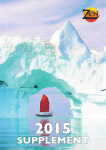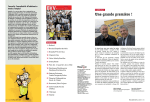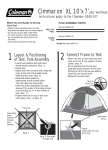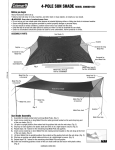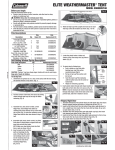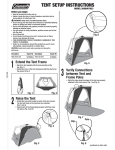Download Eureka! Tents Copper Canyon 1610 User's Manual
Transcript
Assembly Instructions for Copper Canyon 1610 Component List: 1 Tent Body, 6 Wall Poles, 3 Roof Poles, 2 Brim Rods, 1 Fly with Guy Ropes, 1 Carry Bag, 1 Stake Bag/Stakes, 1 Pole Bag 1. Remove from the carry bag and separate all the components. Unroll and unfold the tent fabric with the top side up, on a clean, dry space and open the doors. If windy, stake down the windward corner. This is a large tent, you will need two people for set-up. See fig 1. 4. Raise the tent. Start on one end and insert black wall poles into the corner elbows. At the bottom of each pole, insert the pin/ring (attached to the corner web) into the bottom of each pole. Repeat on the other end. Next, install the tan poles at the center. With the tans, it works best to insert the ring/pin first and then fit the pole into the elbow. See fig 6, 7 & 8. Repeat on the other side until the tent is at full height and freestanding. fig 6 fig 12 fig 8 fig 7 fig 1 Roof poles 2. Assemble the shock corded poles and divide according to size and shape. Corner Take care; make sure that Wall poles each pole section is fully seated into the next. Do not Center allow the sections to snap Wall poles together as this can damage the ends. See fig 2. Brim Rods fig 2 3. Insert the roof poles. Slide both black roof poles into their sleeves sewn on the tent body. They should run from corner to corner crossing in the center. The sleeves are color coded with black trim. Fit one end of each into a nylon elbow attached to the roof corners at A and B. Move to the opposite side, arch the poles and again fit into the nylon elbows at C and D. Insert the gray roof pole, front to back, into the remaining sleeves and over the two black poles. Fit the gray poles into the elbows at E and F. See fig 3, 4 & 5. C fig 3 B fig 13 9. Attach the shock corded J-hooks from the fly to the nylon rings on the webs at the bottom of the poles. See fig 15. 6. Stake the tent down through the web loops. Stake opposite corners while applying tension to smooth the floor wrinkles. Next, align the center poles and stake down. Do this before you add the fly. See fig 10 & 11. 10. Guy out the tent. This tent has very large straight walls that act differently in high winds. There are pre-attached guy out ropes in the pockets on the fly at the top of each pole. Stake out the ropes and adjust tension with the sliders. Additional guy out instructions on the back side of this sheet. See fig 16. fig 10 fig 9 11. Tent door has “Sweep Out” feature. Stake the web loop (inside the door) to the ground to easily whisk dirt out of the tent. See fig 17. fig 14 fig 15 fig 16 fig 11 A E NOTE: One arm of each center elbow has interior ribs. The gray roof poles insert into the ribbed arms. Wall poles insert into the plain arms. fig 4 8. Attach the brim rods. At one end of the tent, reach under the fly and slide an assembled brim rod through the sleeve. See fig 13. Locate the grommets at the corner of the tent and insert the tips of the brim rods into these grommets. Repeat at other end. See fig 14. 5. Attach all clips to the wall poles. See fig 9. F D 7. Attach the fly to the tent. Turn the fly right side up and orient it along the length of the tent. Grasp two corners of the of the fly and drag them up and over the roof to completely cover the tent. (This is much easier with two people.) The brim rod sleeves should hang out over the tent ends. At the wall poles, reach under the fly and attach the hook & loop straps to the poles just below the elbow and down the length of the poles, securing the fly in place. See fig 12. fig 17 fig 5 Take Down: Pull up all stakes. Release the fly’s hook & loop straps and J-hooks. Remove fly. Remove clips from wall poles and pull poles off of the pins. Remove roof poles. Collapse all poles and stow. Fold the tent onto itself then fold the fly and lay it on tent. Roll up both towards an open door and stow. Options: Floor Saver- med. square, Gear Lofts- A & F, and a 120v Rope Light REV. B 4.09 electrocution or electric shock hazard The use of the Power Port to run an extension cord into the tent could result in electrocution or electric shock, or fire or explosion hazards, which could cause death, serious injury, or permanent disability. For these reasons, when using the Power Port: DO follow all warnings, instructions, and safety precautions from the manufacturer of the extension cord. DO connect extension cord only to a 120 Volt GFCI protected outlet with proper ground. If GFCI outlet is not available, use an extension cord with GFCI protection built in. DO use only extension cords that are marked for OUTDOOR USE. DO make sure the part of the extension cord that is outside the tent is lower than the Power Port so that rain will not follow the cord into the tent. DO store extension separately from tent. DO NOT allow extension cord or any electrical device to come into contact with water or condensation inside the tent. DO NOT use extension cord if it is worn or damaged. DO KEEP ALL FLAME AND HEAT SOURCES AWAY FROM THIS TENT FABRIC. This tent meets the flammability requirements of CPAI-84.The fabric may burn if left in continuous contact with any flame source. The application of any foreign substance to the tent fabric may render the flame-resistant properties ineffective. DO NOT operate any device which burns fuel inside your tent. Combustion consumes oxygen and can produce dangerous levels of carbon monoxide, which could lead to serious injury or death. Your failure to follow these warnings could cause death, serious injury or permanent disability to you or others. SEAM SEALING: We recommend use of a sealer such as Kenyon Seam Sealer 3 or McNett Outdoor SeamGrip®. • Work in a fully ventilated area. • Set the tent up or lay the tent out flat. Taut seams allow for even application and penetration of the sealer. • Decide which seams need to be sealed. For example, seams that will be exposed to rain, runoff, or ground level water are a must for sealing, while seams on uncoated nylon or mesh panels don’t need treatment. There is no need to seal the seams in the roof or the factory taped seams. We recommend sealing both floor and fly seams and reinforcements. • Apply sealant to the inside and outside of all exposed seams. Several thin layers will work better than one thick layer. Read and follow manufacture’s instructions. STAKING: All tents need to be staked down to keep them from blowing away. Securing the tent by placing heavy objects inside is just not adequate. • Once the tent body is erected, stake it out before the fly is put on. This enables you to square the tent up to ensure that the fly goes on properly and that the seams align with the frame. Pull the base of the tent taut between each web stake out loop or ring & pin. Make sure that all corners are square. It is important that you don’t stake the tent out too tightly. You will know it’s too tight, if the door zippers can not be easily operated. Drive stakes through the web loops, or with ring & pin, drive the stake just outside the ring so that the “J” hook catches it. Tie a piece of cord or web into a loop through the ring to be used as a large stake loop if needed. • With the tent properly staked, drape the fly over the frame, attach its tent connection points and stake down any pull outs. • Do not attempt to remove the stakes by pulling on the tent becket loop, as this could cause the fabric to tear. The best way is to pry on the stake itself. Staking in special conditions: • Sand. Use long, broad stakes with plenty of surface area in loose soil. • Hard, Rocky, or Frozen Soil. Steel stakes work best. Store steel stakes separately. Their sharp edges can cut fabric and leave rust stains, which might damage your tent. • Snow. Use “dead man” anchors. Tie tent to buried objects (branches, tent bags, or stuff sacks filled with snow; or tie tents to snow shoes, skis, or ski poles, which are stuck in the snow. GUY LINES: Do not depend upon staking alone to keep your tent secure during high winds. The Copper Canyons have built-in loops and guy lines at optimal guy out locations. It’s important to put in the extra time guying out your tent. Correctly done, it can save your tent during exceptional weather. • Make sure that the top fly is securely attached to the tent frame. Hook and loop fasteners are sewn to the underside of the fly for this purpose. • There are guyout points with guylines preattached at primary locations. Stake those guylines 6’ from the edge of the tent. The optimal angle from the ground to the guyline is 45˚. See fig a. • In high winds guylines should be attached to the secondary web loops on each corner, and center on the 1312/1512, and halfway down the tan mid-poles on the 1312 and 1512. See fig b. Attach parachute cord and stake per the previous notations. This prevents all movement, except toward the anchor. The guy lines will work together through opposition. See illustrations below: fig a fig b CONDENSATION & VENTING: Through perspiration and breathing, an adult gives off about a pint of water overnight. If it cannot escape, the water vapor condenses to liquid. Most often, water found in the tent is a result of this condensation rather than from the tent leaking. Condensation often forms where the sleeping bag touches the side of the tent, under the sleeping pad, or on coated surfaces such as the door flaps. A tent’s double wall construction allows the vapor to escape through the roof to the outside, keeping the inside of the tent dry. Leave the windows partially open at night to provide cross ventilation and further reduce condensation. Cross ventilation becomes more important in very humid or extremely cold conditions when the permeable roof is less effective. The features that enhance ventilation are windows, short-sheeted flys (bottom venting), roof vents, and High/Low venting doors. These are specific to each tent model. Given the importance of proper ventilation, We use High/Low venting in most of our tents. This allows cooler air in through the low vents and warmer, moist air up and out through the high vents. High/Low venting is accomplished within the inner tent via roof vents, doors and windows. It is important to vent the vestibule. Unvented, it can inhibit airflow into the tent. Eureka! tent vestibules profit from the ability to “short sheet” by means of zippers & toggles and staked vestibule pull outs create a bellowing effect. Most of our tents are equipped with a High/Low venting door. This design allows increased airflow into the tent from the bottom. Open the low vent/window to admit cool air, allowing the warmer air out through the high roof vents. When rain and wind prevent the low vent from being opened, the high door vent can still be used. Fly overhangs or vestibules protect it. ULTRAVIOLET LIGHT: Ultraviolet light damage to tent fabric is caused by excessive exposure to sunlight. While our fabrics are UV resistant, any synthetic fabric is susceptible to UV degradation. UV damage will cause nylon and polyester to become brittle and tear easily. We recommend that you use the rain fly even on clear days. It acts as a sunscreen to the tent. A rain fly is both easier and less expensive to replace if damaged. UV damage can be minimized by erecting tents on shaded sites with low exposure to direct sunlight. GENERAL POLE CARE: • Never let tent poles snap together as this can damage the pole end. • Do not drop tent or pole bags on their ends and do not bounce a tent bag on its end to get the tent out. These actions may cut the shock cord and damage the pole ends. • The aluminum frame may bend slightly and take a “set” through usage; this normally does not affect the performance of the frame. GENERAL TENT CARE: • Sweep the tent floor daily to prevent damage from stones. • Try not to wear shoes inside your tent. • Use a ground cloth whenever possible. • Do not keep food inside a tent. Hungry critters will chew through tent fabric in search of food. STORAGE: • Make sure the tent is completely dry, then store loosely rolled, in a dry, cool place. To prevent dust from collecting on the tent, cover it with a cloth. This allows the nylon/polyester fabric to breathe. • Ideally, the tent poles should be stored in their fully assembled state. This reduces the tension on the shock cord, prolonging its life. • The tent bag should be used only as a carry sack and not for storage. COLOR TRANSFER: • Do to the nature of tent fabrics, color can transfer from darker to lighter fabrics when the two fabrics are in contact over time when wet, damp or exposed to the combination of moisture and high heat. This does not effect the tent’s performance. To prevent / minimize color transfer, always make sure your tent is completely dry prior to packing and storage. CLEANING: • Clean the tent by setting it up and wiping it down with a mild soap (liquid hand soap) and lukewarm water solution. Rinse thoroughly and dry completely. Never use detergent, washing machines or dryers because they can damage the tent’s protective coating and seams. After cleaning, be sure the tent is completely dry, especially the heavier, double-stitched areas such as the seams, before storing or mold / mildew are likely to grow. • Clean the tent poles with a cloth and lubricate them with silicone spray. This is especially necessary after ocean side camping to remove salt spray so the poles don’t corrode or stay gritty. • Clean the zippers with a quick dip in water and then dry them off. This is especially important if you’ve been camping in a location with sand/dirt. If you don’t clean the zippers, the sliders will wear out and eventually the teeth will become inoperable. ALTERATIONS OR MODIFICATIONS: DO NOT misuse, modify or alter this product in any way from its condition at the time of sale. Alteration, modification or any use of this product contrary to the accompanying written instructions shall void the warranty. Moreover, any misuse, alteration or modification of the product shall absolve Johnson Outdoors Gear LLC. of any liability for property damages or injuries sustained as a result of such misuse, modification or alteration. LIMITED WARRANTY: What Is Covered: Johnson Outdoors Gear LLC warrants to the original purchaser that its Copper Canyon tents are free from defects in material and workmanship, for the life of the product, except as qualified below. The life of the product is determined from the date of purchase until such time as the product is no longer serviceable due to normal wear and tear. What Is Not Covered: Johnson Outdoors Gear LLC shall not be responsible for the natural breakdown of materials that occurs inevitably with extended use (e.g., Ultra Violet (UV) light damage on tents, exhausted zippers), or defects caused by accident, abuse, alteration, animal attack, storm damage, misuse or improper care. THERE ARE NO OTHER EXPRESS WARRANTIES BEYOND THE TERMS OF THIS LIMITED WARRANTY. IN NO EVENT SHALL JOHNSON OUTDOORS GEAR LLC BE LIABLE FOR INCIDENTAL OR CONSEQUENTIAL DAMAGES. Some states do not allow the exclusion or limitation of incidental or consequential damages, so the above limitation or exclusion may not apply to you. What Johnson Outdoors Gear LLC Will Do: If after inspection we find that a product failed due to a manufacturing or material defect, we will repair or replace the product, at our option, without charge. How to Obtain Warranty Service: Return the product, freight prepaid, to the Dealer from whom it was purchased; or, contact our Customer Satisfaction Department for return authorization: toll free 1-800-572-8822. Collect shipments or shipments without return authorization cannot be accepted. The product registration card packaged with our product need not be returned for the warranty to be effective and for you to receive warranty service. Repairs: If your Johnson Outdoors Gear LLC product needs service or repair due to normal wear and tear, animal attack, accident or some other reason that is not covered under the warranty we will provide the necessary service for a reasonable charge, plus shipping and handling. We require that products accepted for any repair be properly cleaned according to our recommended care instructions. Please send your product or component that requires repair (e.g., tent fly), postage prepaid, along with a description of what needs attention. For service and repairs, please contact our Customer Satisfaction Department: toll free 1-800-572-8822 How State Law Relates To This Warranty: This warranty gives you specific legal rights, and you may have other rights that vary from state to state. JOHNSON OUTDOORS GEAR LLC We support the “Leave No Trace” Seven Principles 1. PLAN AHEAD AND PREPARE 2. TRAVEL & CAMP ON DURABLE SURFACES 3. DISPOSE OF WASTE PROPERLY 4. LEAVE WHAT YOU FIND 5. MINIMIZE CAMPFIRE IMPACTS 6. RESPECT WILDLIFE 7. BE COURTEOUS OF OTHER VISITORS REV D. FEB-09






